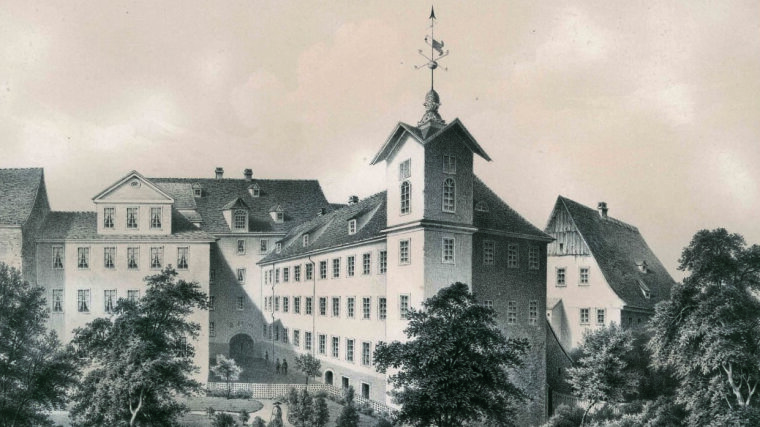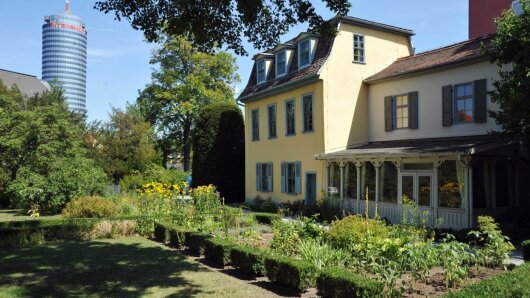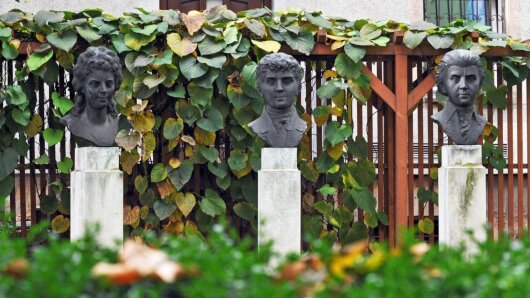
Modernity has its roots in the Enlightenment and Romanticism. Germany’s romanticist roots are in Jena, where the leading academics would meet at the end of the 18th century to set new artistic standards and cultivate a lively intellectual conviviality. There is so much more to Romanticism than the glorification of nature and emotional infatuation—and that still rings true today.
By Ute Schönfelder
What does romantic even mean?
The term »romantic« was originally used to describe the characteristics of romance in a narrative, so it refers to a concept which is »like something out of a novel«. A similar term is used to describe a family of languages that evolved from Latin, such as French, Spanish and Italian. From the late Middle Ages to the 17th century, most novels (mostly tales of chivalry) were written in these »Romance languages«. Romantic poets were inspired by medieval topics and stories, often telling them in the form of fairy tales and myths.
The dawn of a new era
Romanticism followed the Age of Enlightenment immediately after the French Revolution. In Germany, this new era began in Jena around the year 1796. From 1805 onwards, the »High Romanticism« movement spread mainly from Heidelberg and Berlin. Berlin, Vienna and Munich became the centres of Late Romanticism from 1818. These were troubled times from a socio-political perspective—after all, France wasn’t the only country that underwent a change from feudalism to bourgeois society, bringing about new freedoms and civil rights. The Romanticists perceived this spirit of change in their work and developed their own air of academic self-confidence. In its early days in Jena, Romanticism was a progressive, avant-garde movement that brought about completely new forms of expression.
The fact that Jena was the starting point for the Romantic movement in Germany is thanks to its university, where Friedrich Schiller and Johann Gottlieb Fichte taught at the time. Johann Wolfgang Goethe was the minister responsible for the university and often stayed in the city. Schiller advised the 28-year-old philologist and literary critic August Wilhelm Schlegel to move to Jena in 1796. He was followed by his younger brother, Friedrich, who was a philosopher, art critic and literary critic. August Wilhelm was appointed to the university as an associate professor in 1798, in the same year as Friedrich Wilhelm Joseph Schelling. Thanks to its university, Jena became the centre of intellectual and cultural life in Germany—if it hadn’t been for this institution, the Romantic philosophers and writers certainly not’t have been attracted to the city.
Shared house and workshop
The true centre of Early Romanticism in Jena was a house on the former street called Leutragasse, where August Wilhelm and Caroline Schlegel lived from 1796. Friedrich Schlegel also moved in later that year—before relocating to Berlin in 1797. In 1799, he returned to the shared accommodation in Jena with his lover Dorothea Veit. The famous »Romanticist Gathering« then took place in November 1799, attended by the four residents of the house along with Friedrich von Hardenberg (Novalis), Friedrich Wilhelm Joseph Schelling and Ludwig Tieck. They spent five days engaged in work and discussions as they read to one another, ate and drank together, combining an air of conviviality with a workshop-like atmosphere.
If you want to look for the original location where the Romanticists lodged together, you will need a lot of imagination… After all, the house was located on the site of today’s Eichplatz—in the middle of a car park. The house was destroyed at the end of the war in 1945—and the Leutragasse was demolished a few years later along with the entire historical city centre. However, the birthplace of Romanticism in Jena can still be seen from the »Jentower«.
Jena’s Romanticists would probably see this architectural specimen as an homage to their grandeur. Their thematic ideas were revolutionary: Friedrich Schlegel completely redefined literature with his »progressive universal poetry«. He described it as a proverbially »limitless«, cross-genre form of art that is constantly evolving, fed solely by the author’s imagination and creativity and without the restrictive corset of the poetry rules that had been widespread up to that point. Schlegel wanted to combine literature, philosophy and criticism.
Early Romanticists were distinguished by their fragments that were mostly published in the journal »Athenaeum«, which acted as the mouthpiece of Early Romanticism in Jena from 1798 to 1800. The few sentences in these short texts reflected the authors’ thoughts on philosophy, art and social issues. They were mostly written in an ironic, controversial and provocative manner—and quite deliberately in an »unfinished« form. Friedrich Schleiermacher, a leading theologian of the Romantic era, once described the fragments as »critical shavings« that were intended to ignite independent thought. Many fragments are playful and reveal the fun the authors must have had when writing them.
Emancipation and conviviality
The early Romanticists in Jena also demonstrated their passion for experimentation and their joie de vivre in their lifestyle. The non-conformist shared house in Jena was a place of liberal conviviality, where people would meet to take part in theatrical performances, attend readings and discuss topics, inspired by the salons of Paris. The early Romanticists would wear the latest French fashion, catching the eye of many a passer-by in what used to be a small university town with around 4,500 inhabitants. Friedrich Schlegel and Dorothea Veit must have caused quite a stir with their »wild marriage«—and August Wilhelm and Caroline Schlegel were arguably in an open relationship by today’s standards.
The role of women in Romantic circles was truly remarkable—not only in terms of their social position. They were also intellectually emancipated, albeit within their own environment (women would have to wait another hundred years until they were allowed to study or even teach at university). Caroline Schlegel worked with her husband August Wilhelm Schlegel on translations of the works of Shakespeare. Dorothea Veit wrote her own novel (»Florentin«), which was published anonymously by her partner Friedrich Schlegel in 1801. The male Romanticists saw their wives as their equals—even if they caused a lot of social controversy. The early-Romantic ideal of a partnership was described by Friedrich Schlegel in his novel »Lucinde« as a sensual, emotional and intellectual interaction between the characters Julius and Lucinde, creating a sharp contrast to the »marriage of convenience« that had been portrayed in previous eras.

